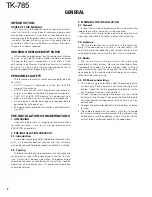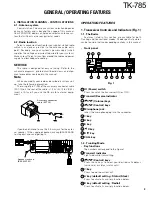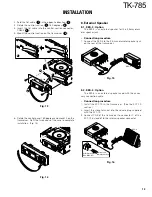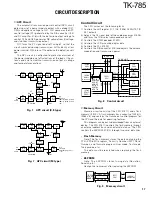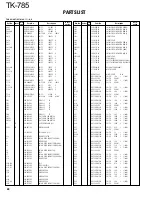
14
TK-785
Frequency Configuration
The TX-RX unit incorporates a VCO, based on a fractional
N type PLL synthesizer system, that has 12.5kHz. The in-
coming signal from the antenna is mixed with a first local
oscillation frequency to produce a first intermediate fre-
quency of 44.85MHz.
The signal is then mixed with a second local oscillation
frequency of 44.395MHz to produce a second intermediate
frequency of 455kHz. This is called a double-conversion
system. The transmit signal is produced by the PLL circuit
for direction oscillation and division. The signal output from
the VCO is amplified by a straight amplifier and transmitted.
ANT
SW
RX
AMP
1st
MIX
TX
AMP
POWER
AMP
CF2 455kHz
MCF
44.85MHz
–
+
MIX/IF/DET
172.15~190.15MHz
: K,E
205.15~225.15MHz
: M
PLL/VCO
VCXO
16.8MHz
218~235MHz : K,E
250~270MHz : M
217~235MHz : K,E RX
218~235MHz : K,E TX
250~270MHz : M
44.395MHz
AFO
MD
MB
Fig. 1
Frequency configuration
Receiver System
■
Outline (K,E type)
The incoming signal from the antenna passes through a
low-pass filter and a transmission/reception selection diode
switch (D211) and goes to the front end of the receiver. The
front-end filter is a variable BPF consisting of three coils and
three varicap diodes (D206, D207, D208) to eliminate un-
wanted out-of-band signal components. The low-noise am-
plifier (LNA) (Q202) uses a bipolar transistor to achieve wide-
band and low-distortion amplification.
LPF
ANT
HPF
L202~204
BPF
Q202
AMP
Q15
AMP
IC2
AMP
IC202
MIX
XF1
BPF
D211,212
ANT
SW
–
+
CF2
IC11
MIX,IF,DET
X2
2nd
local OSC
1st local
OSC (HT)
DEO
Fig. 2
Receiver system (K,E type)
CIRCUIT DESCRIPTION
The signal passes through the BPF and is down-con-
verted with the first local signal by IC202 to produce the first
IF signal of 44.85 MHz. The first local signal passes through
an LPF and an attenuator to eliminate unwanted harmonics
components and implement the optimum input level to the
mixer, then enters IC202. A DBM is used as a mixer to
achieve a high potential.
The signal output from the mixer passes through two
MCFs (XF1). The signal is amplified by an intermediate fre-
quency amplifier and input to the FM IF IC (IC11).
The first intermediate frequency signal is mixed with the
second local signal of 44.395MHz to produce the second IF
signal of 455kHz.
The unwanted near-by signal components are then elimi-
nated by a ceramic filter (CF2) and the resulting signal goes
back to the FM IF IC. The signal is quadrature-detected in
the IC to produce an audio signal, which is amplified by a
DET amplifier (IC2) and output to the control unit.
■
Outline (M type)
The incoming signal from the antenna passes through a
low-pass filter and a transmission/reception selection diode
switch (D209) and goes to the front end of the receiver. The
front-end filter is a variable BPF consisting of two two-pole
helical resonators and eight varicap diodes (D203, D204,
D205, D206, D212, D213, D214, D215) to eliminate un-
wanted out-of-band signal components. The low-noise am-
plifier (LNA) (Q201) uses a bipolar transistor to achieve wide-
band and low-distortion amplification.
The signal passes through a BPF and is down-converted
with the first local signal by IC200, then converted to the
first IF signal of 44.85MHz. The first local signal passes
through an LPF and an attenuator to eliminate unwanted
harmonics components and implement the optimum input
level to the mixer, then enters IC200. A DBM is used as a
mixer to achieve a high potential.
The signal output from the mixer is amplified by an inter-
mediate frequency amplifier and input to two MCFs (XF1).
The signal is amplified by another intermediate amplifier and
goes to the FM IF IC (IC11). The first intermediate fre-
quency signal is mixed with the second local signal of
44.395MHz to produce the second IF signal of 455kHz.
The unwanted near-by signal components are then elimi-
nated by a ceramic filter (CF2) and the resulting signal goes
back to the FM IF IC. The signal is quadrature-detected in
the IC to produce an audio signal, which is amplified by a
DET amplifier (IC2) and output to the control unit.
Содержание TK-785
Страница 69: ...TK 785 TK 785 TK 785 BLOCK DIAGRAM K E 95 ...
Страница 70: ...TK 785 TK 785 TK 785 96 BLOCK DIAGRAM M ...


